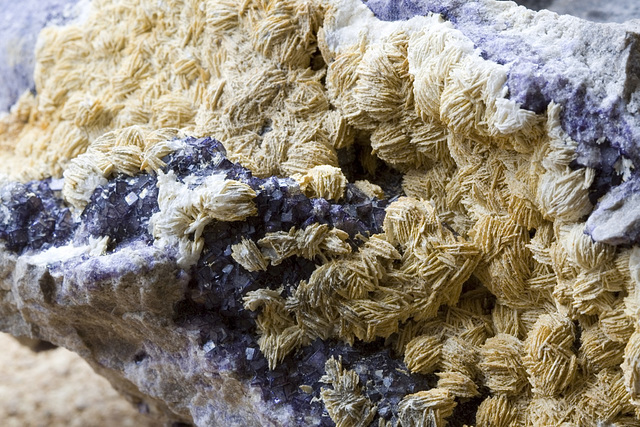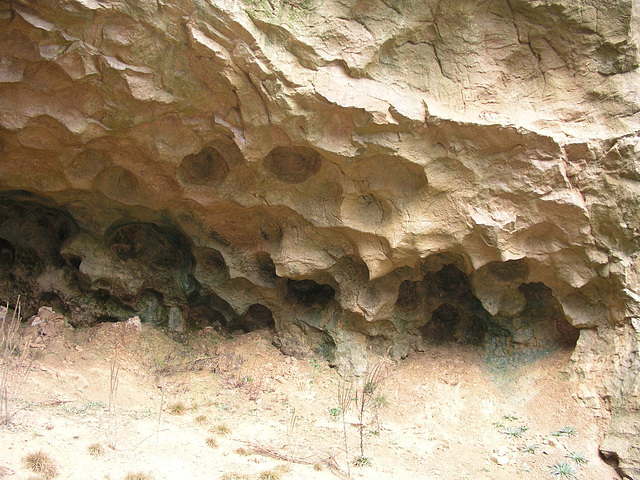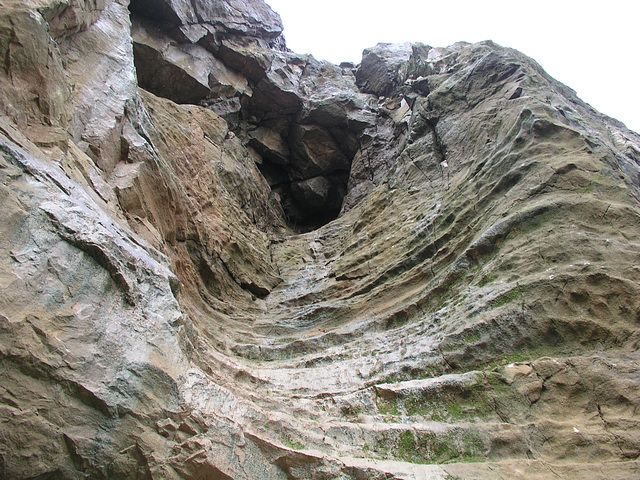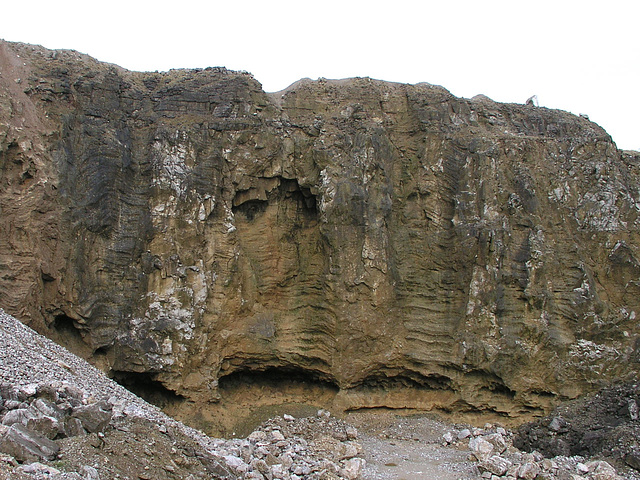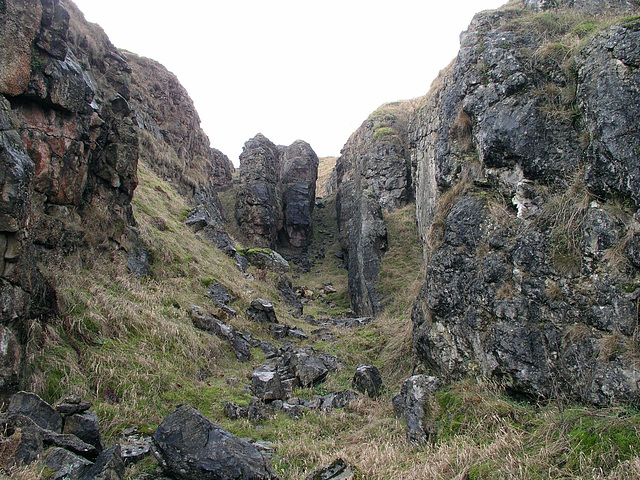
Dirtlow Rake
Folder: Peak District
Dirtlow Rake is a major mineral vein near Castleton, Derbyshire, in the northern part of the White Peak. The principal metallic mineral worked was galena, lead sulphide PbS. This has been worked along the vein since at least medieval times; at first by 'open works' along the length of the vein, cutting a slot through the limestone host rock, and somewhat later by many shafts sunk along the vein. …
(read more)
Dirtlow Rake gems 2
A closer view of yellow barytes (BaSO4) and purple fluorite "Blue John" (CaF2) from Dirtlow Rake, near Castleton, Derbyshire.
Width of view: approx 4 cm.
Dirtlow Rake gems 1
Yellow barytes (BaSO4) and purple fluorite "Blue John" (CaF2) on grey Carboniferous limestone from Dirtlow Rake, near Castleton, Derbyshire.
Width of view: approx 7 cm.
Dirtlow Rake quarry; cave system in cross section
This photo shows part of the modern open quarrying for fluorite and barytes along the line of Dirtlow Rake near Castleton, on the site of the former Hollandtwine Mine. This is a rather special place. On the far north-west wall, the quarrying has cut a perfect cross section through a cave system. There are vertical vein cavities with horizontal fluting. These lead down to a meandering horizontal passage about 20 m below the original ground level. This passage must have been a phreatic tube at one time - entirely below the water table. The scalloping seen in the supplementary photos is a typical solution feature seen in these sort of tubes.
Finally, there is a lot of fine yellow-ochrous loose sediment infilling some of the swallets and partially choking up the phreatic tube. I think this is a loess deposit - a fine wind-blown dust originating from rock 'flour' ground up by ice-age glaciers. In the last glacial period (the Devensian) the Peak District was largely free of ice, although it was under cold, permafrost conditions. Strong winds around the periphery of the ice sheets blew all the dust around which accumulated in pre-existing hollows and fissures on the formerly glaciated surface.
So, this quarry has enabled us to see karst (solution) and periglacial features that would normally only be accesible to cavers. I would hope that some of this quarry face would be preserved, but my understanding is that the whole lot will be backfilled and grassed over, so we will end up with a tidy, bland, green grassy area which tells us nothing at all. :-( But I suppose it will keep the planning authorites happy.
Dirtlow Rake quarry; phreatic tube in cross section
This photo shows part of the modern open quarrying for fluorite and barytes along the line of Dirtlow Rake near Castleton, on the site of the former Hollandtwine Mine. This is a rather special place. On the far north-west wall, the quarrying has cut a perfect cross section through a cave system. There are vein cavities with horizontal fluting. These lead down to a meandering horizontal passage about 20 m below the original ground level. This passage must have been a phreatic tube at one time - entirely below the water table. The scalloping seen in this photo is a typical solution feature seen in these sort of tubes.
Finally, there is a lot of fine yellow-ochrous loose sediment infilling some of the swallets and partially choking up the phreatic tube. This infill can be seen in the lower part of the photo. I think this is a loess deposit - a fine wind-blown dust originating from rock 'flour' ground up by ice-age glaciers. In the last glacial period (the Devensian) the Peak District was largely free of ice, although it was under cold, permafrost conditions. Strong winds around the periphery of the ice sheets blew all the dust around which accumulated in pre-existing hollows and fissures on the formerly glaciated surface.
So, this quarry has enabled us to see karst (solution) and periglacial features that would normally only be accesible to cavers. I would hope that some of this quarry face would be preserved, but my understanding is that the whole lot will be backfilled and grassed over, so we will end up with a tidy, bland, green grassy area which tells us nothing at all. :-( But I suppose it will keep the planning authorites happy.
Dirtlow Rake quarry; vein cavity in cross section
This photo shows part of the modern open quarrying for fluorite and barytes along the line of Dirtlow Rake near Castleton, on the site of the former Hollandtwine Mine. This is a rather special place. On the far north-west wall, the quarrying has cut a perfect cross section through a cave system. There are vertical vein cavities with horizontal fluting. The photo shows a portion of one of these.
The vein cavities are associated with a meandering horizontal passage about 20 m below the original ground level. This passage must have been a phreatic tube at one time - entirely below the water table. The scalloping seen in the supplementary photos is a typical solution feature seen in these sort of tubes.
This quarry has enabled us to see karst (solution) and periglacial features that would normally only be accesible to cavers. I would hope that some of this quarry face would be preserved, but my understanding is that the whole lot will be backfilled and grassed over, so we will end up with a tidy, bland, green grassy area which tells us nothing at all. :-( But I suppose it will keep the planning authorites happy.
Dirtlow Rake quarry; cave system in cross section 2
This photo shows part of the modern open quarrying for fluorite and barytes along the line of Dirtlow Rake near Castleton, on the site of the former Hollandtwine Mine. This is a rather special place. On the far north-west wall, the quarrying has cut a perfect cross section through a cave system. There are vertical vein cavities with horizontal fluting. These lead down to a meandering horizontal passage about 20 m below the original ground level. This passage must have been a phreatic tube at one time - entirely below the water table. The scalloping seen in the supplementary photos is a typical solution feature seen in these sort of tubes.
Finally, there is a lot of fine yellow-ochrous loose sediment infilling some of the swallets and partially choking up the phreatic tube. I think this is a loess deposit - a fine wind-blown dust originating from rock 'flour' ground up by ice-age glaciers. In the last glacial period (the Devensian) the Peak District was largely free of ice, although it was under cold, permafrost conditions. Strong winds around the periphery of the ice sheets blew all the dust around which accumulated in pre-existing hollows and fissures on the formerly glaciated surface.
So, this quarry has enabled us to see karst (solution) and periglacial features that would normally only be accesible to cavers. I would hope that some of this quarry face would be preserved, but my understanding is that the whole lot will be backfilled and grassed over, so we will end up with a tidy, bland, green grassy area which tells us nothing at all. :-( But I suppose it will keep the planning authorites happy.
Cave system exposed by Dirtlow Rake quarry near Castleton, Derbyshire.
This photo shows part of the modern open quarrying for fluorite and barytes along the line of Dirtlow Rake near Castleton, on the site of the former Hollandtwine Mine. This is a rather special place. On the far north-west wall, the quarrying has cut a perfect cross section through a cave system. There are vertical vein cavities with horizontal fluting. These lead down to a meandering horizontal passage about 20 m below the original ground level. This passage must have been a phreatic tube at one time - entirely below the water table. The scalloping seen in the supplementary photos is a typical solution feature seen in these sort of tubes.
Finally, there is a lot of fine yellow-ochrous loose sediment infilling some of the swallets and partially choking up the phreatic tube. I think this is a loess deposit - a fine wind-blown dust originating from rock 'flour' ground up by ice-age glaciers. In the last glacial period (the Devensian) the Peak District was largely free of ice, although it was under cold, permafrost conditions. Strong winds around the periphery of the ice sheets blew all the dust around which accumulated in pre-existing hollows and fissures on the formerly glaciated surface.
So, this quarry has enabled us to see karst (solution) and periglacial features that would normally only be accesible to cavers. I would hope that some of this quarry face would be preserved, but my understanding is that the whole lot will be backfilled and grassed over, so we will end up with a tidy, bland, green grassy area which tells us nothing at all. :-( But I suppose it will keep the planning authorites happy.
Best viewed large....
Dirtlow Rake openworks, near Castleton, Derbyshire
Originally uploaded for the GuesswhereUK Group.
This is part of Dirtlow Rake lead vein 'openworks' where the vein has been excavated from the surface leaving a slot with walls of limestone on each side. In this particular location the vein splits into a complex of several branching and rejoining sub-parallel veins formed along a strike-slip duplex fault structure. Most of the movement along the faults was near-horizontal as evidenced by horizontal slickensides (groove marks) along the vein walls.
This part of the vein has been worked since medieval times. In the floor of the opencut are numerous old shafts which accessed the deeper parts of the vein mostly from the 16th and 17th century onwards.
Dirtlow Rake 'open works'
The photograph is of 'open works' along the Dirtlow Rake mineral vein, between Pin Dale and Cavedale, near Castleton. The vertical slot is where lead miners have removed the vein, from medieval times onwards. Later workings took place underground and there are many old shafts along the length of the vein.
The view is eastwards along the vein. The small 'bump' on the skyline is Win Hill. The village of Hope lies hidden beyond the green fields in the middle distance.
Jump to top
RSS feed- Latest items - Subscribe to the latest items added to this album
- ipernity © 2007-2025
- Help & Contact
|
Club news
|
About ipernity
|
History |
ipernity Club & Prices |
Guide of good conduct
Donate | Group guidelines | Privacy policy | Terms of use | Statutes | In memoria -
Facebook
Twitter



